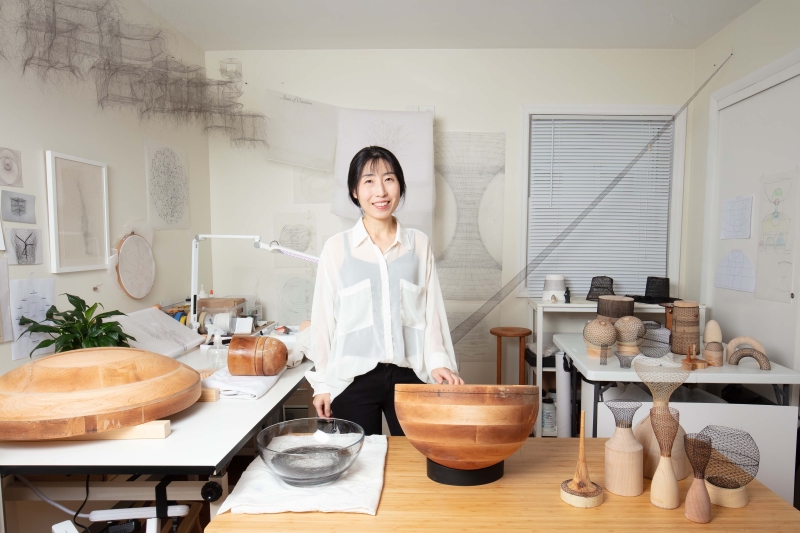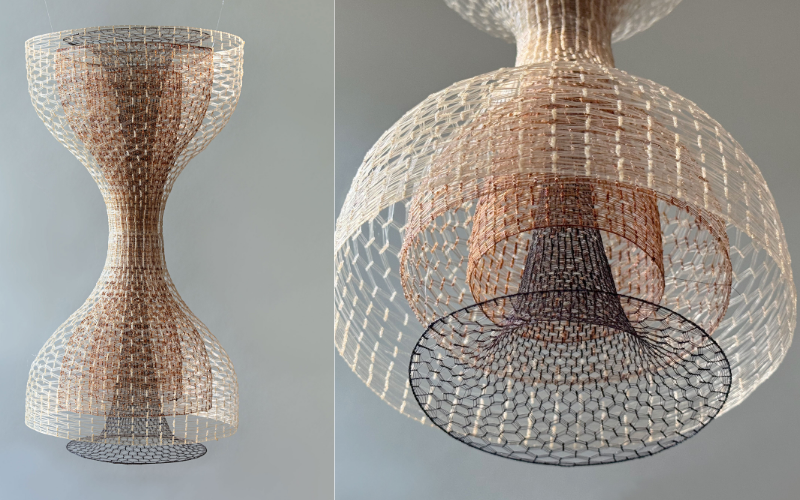Jayoung Yoon is a visual artist using human hair and other natural materials, including feathers, milkweed seed fiber, and horsehair, as mediums. She was born and raised in Korea and moved to the USA in 2006 to continue her education. She currently works and lives in New York.
She has recently begun using traditional Korean horsehair weaving techniques in her work. Traditional Korean horsehair weaving is a remarkable technique that involves weaving strands of horsehair into various items, including hats, belts, baskets, etc.
Jayoung Yoon received the 2023 Joan Mitchell Fellowship, an award that recognizes and supports 15 US-based artists who are working in the fields of sculpture, art installation and painting.
She has showcased her work in numerous exhibitions, including those at The Bronx Museum of the Arts in NY, Studio 3 Gallery in Canterbury, UK, and B53 Gallery in Arnhem, Netherlands. Her work has also been featured in publications like The New Yorker, The Paris Review, and Fiber Art Now.
In this interview, Jayoung Yoon talks about her work and explains the techniques behind her art, providing a detailed look at the skill and artistry involved. Her insights offer both education and inspiration.
The following are excerpts from an email interview with her from June 28 to July 9.

1. Where did the inspiration to use human hair as a primary medium in your work come from?
I grew up in Korea in the 1980’s, hearing stories from my family about Japan’s 35-year occupation, the Korean War, the division into North and the Republic of Korea, and decades of military regimes. When I was young, I frequently had to rush home because the military police deployed harmful tear gas against student protesters. All these direct and indirect experiences informed my understanding of the human condition. I searched for my own ways of processing suffering, cleansing memories, and moving toward healing.
This profoundly influenced me and became integral to my art.I was seeking a material that could visually represent the purification of my thoughts through its inherent qualities and the process of working with it. I discovered that human hair possesses the ability to encapsulate both the abstract and the tangible. As I weave and knot each strand of hair into delicate structures that are predominantly airy, my sculptures take on a semi-transparent quality, reminiscent of intangible thoughts and memories. Additionally, hair embodies substance through its visceral, tactile nature, serving as a literal trace and product of the human body.
2. Later, why did you decide to learn traditional Korean horsehair weaving techniques and who taught you this skill?
During my visit to Korea in 2019, I took a class to learn Korean traditional embroidery (Jasu) at the Yongsan Art & Craft Center. In one of the classrooms, I saw a ''Tang-geon,'' one of the traditional hats made of horsehair, displayed. I was fascinated by its semi-transparent beauty and delicate structure, which resonated with my own works. I looked into where I could learn these techniques and discovered that several masters, recognized as Intangible Cultural heritage, still pass down the traditional horsehair weaving technique on Jeju Island. In the summer of 2023, I journeyed to Jeju Island, and learned Korean traditional horsehair weaving from an instructor for successor training (전승교육사) of ''Tang-geon'' for a month. This experience granted me profound insights into these traditional methods.
3. What is the process of the Korean horsehair weaving technique? Could you provide a brief overview of this method?
In the weaving process, wooden forms are employed to interlace strands of horsehair with a needle. After the weaving is completed, the woven horsehair is affixed to the wooden form and immersed in boiling water for a duration ranging from 30m to 2h, depending on the intricacies of the applied weaving techniques. This procedure solidifies the shape formed from horsehair.
4. Do you find horsehair easily? Tell us a few words about your crafts with horsehair
I mainly purchase horsehair from stores on Etsy. When choosing it, I try to ensure the company treats horses ethically and does not abuse them to obtain the horsehair. My art is characterized by intricate designs, semi-transparency, a sense of weightlessness, a meditative creation process, and inspiration drawn from nature.

5. How do you ensure the durability and strength of woven horsehair items?
Both human hair and horsehair are primarily composed of keratin, a fibrous protein that makes them naturally durable and resistant to decay. This structure allows horsehair to remain strong over long periods, similar to how human hair can be preserved on ancient mummies for thousands of years.
For the traditional craft like ''Tang-geon,'' we use horsehair that is at least 50cm (20 inches) long, which takes about two years to grow. The ideal thickness is around 200 microns, not too thick or too thin. Each strand is meticulously inspected by hand for consistency, smooth surface, and flexibility, with only about one-fifth or fewer of the horsehairs being selected for use, ensuring the highest quality.
We employ traditional tight weaving methods to create a dense, sturdy structure, which enhances the natural strength of the structure, resulting in a more durable final product.
6. How do you view the future of this craft?
I'm optimistic about the future of horsehair weaving. In our world of mass-produced items, traditional handcrafted horsehair pieces offer a unique tactile experience and subtle quality that machines simply can't replicate.
Over the past decade, I've noticed a significant increase in demand for artisanal skills. This is especially evident at craft fairs and on online marketplaces specializing in handmade goods. People seem to be rediscovering the value of handcrafted items.
What I find particularly meaningful is how this craft serves as a living link to our traditional heritage. The intricate techniques, passed down through generations, are gaining appreciation in our globalized world. This craft's ability to connect us with history while offering something uniquely beautiful for the present is, I believe, key to its lasting significance and continued impact.
7. What are your future plans?
I have begun to implement these traditional techniques and develop a new project titled, “The Fabric of Energy.” My project reimagines traditional craft techniques through sculptural installations and performance art, exploring themes of spirituality, science, and sociopolitical consciousness. It marks a crucial step towards blending tradition with innovation and opens up new possibilities. I'm eager to see how this project will shape my artistic practice in the coming years.
How about this article?
- Like4
- Support2
- Amazing1
- Sad0
- Curious0
- Insightful0


